Table of Contents
- Why It Happens and What to Try First
- Why Your Smoke Alarm Is Beeping (and What It’s Trying to Tell You)
- Why This Beeping Matters
- Don’t Assume It’s a Glitch
- Sensor Types, False Alarms, and What Actually Matters
- Not All Smoke Alarms Are the Same
- Ionization vs Photoelectric Sensors
- Which Is Better?
- False Alarms and Disabled Devices
- Eco-Friendly Considerations
- What to Look For in a New Smoke Alarm
- What If Your Home Has Interconnected Alarms?
- Smart Replacements, Maintenance, and Must-Know Tips
- Recommended Smoke Alarms: What to Buy Next
- Maintenance Tips to Prevent Future Beeping
- FAQs About Smoke Alarm Beeping
- Final Takeaways
- Battery Operated Smoke Alarms
- Hardwired Smoke Alarms
- Special Needs Options
Why It Happens and What to Try First
If your smoke detector won’t stop beeping or chirping, you’re not alone. Most people eventually find themselves standing on a chair at midnight, waving a dish towel and wondering why their alarm is throwing a tantrum. The noise can be relentless, but it’s not random. It’s a signal that something needs attention.
Let’s go over the most common reasons your smoke alarm is making noise, how to figure out what’s wrong, and what steps to take before assuming it’s broken.
Why Your Smoke Alarm Is Beeping (and What It’s Trying to Tell You)
Chirping or beeping smoke alarms are almost always sending a message. The hard part is decoding it. Some beeps mean the battery is low. Others are warnings about sensor issues or internal failure. And sometimes, the alarm just wants to remind you it exists.
Before you rip it off the ceiling in frustration, here’s what to check.
1. Low Battery
This is the most common cause. Many smoke alarms beep once every 30 to 60 seconds when the battery starts dying. Even hardwired smoke alarms often have a backup battery that needs replacing.
What to do:
- Remove the alarm from the wall or ceiling.
- Open the battery compartment.
- Replace the battery with a fresh one of the correct type (usually 9V or AA).
- Put it back and press the test button to confirm it works.
Tip: If your home has interconnected alarms, one low battery can affect the whole system.
2. The Alarm Needs a Reset
If you’ve already replaced the battery and it’s still beeping, a full reset may be needed. Sometimes alarms hold on to error codes that won’t clear on their own.
To reset your smoke alarm:
- Remove the alarm from its mount.
- Disconnect it from power if it’s hardwired.
- Press and hold the test button for 15 to 30 seconds.
- Wait for it to chirp or flash, then release.
- Reconnect and reinstall.
This simple reset often clears out issues that a battery swap alone can’t fix.
3. Dirty Sensor or Dust Buildup
Over time, smoke alarms collect dust and debris. Even small particles or insects can cause false alerts or chirping.
Try this:
- Use a vacuum with a soft brush or compressed air to clean around the vents and sensor.
- Avoid using sprays or cleaners, which can damage the sensor.
- Check that the area around the alarm is free from steam, smoke, or high humidity.
Avoid placing alarms too close to bathrooms, stoves, or vents. Steam from a shower or smoke from cooking can trigger nuisance beeping.
4. End of Life Warning
All smoke alarms have a shelf life. Most last around 10 years. Some models chirp when they reach the end of their service life and need to be replaced.
Check the label:
Look on the back of the unit for a manufacture date. If it’s more than 10 years old, it’s time for a new one. In some models, beeping caused by expiration won’t stop even with a new battery or reset.
5. Power Problems (Hardwired Units Only)
For wired smoke alarms, inconsistent power can cause them to beep.
- Check your circuit breaker to see if the line was interrupted.
- If you’re comfortable, inspect for loose wires (or have an electrician do it).
- After a power outage or surge, some alarms get stuck in alert mode until manually reset.
Why This Beeping Matters
That chirp might be annoying, but it could save your life. The National Fire Protection Association says three out of five fire deaths happen in homes without working smoke alarms. That single beep is your warning system telling you something’s off. Even if it turns out to be a false alarm, it’s better to investigate than ignore it.
Don’t Assume It’s a Glitch
Many people assume the beeping is a fluke or think they’ll get around to it later. But it’s often the first sign of something more serious, like a completely dead unit, a faulty connection, or even an incompatible battery.
Working through these steps might seem tedious, but it’s always worth it. If nothing works, then yes, it may be time to toss it and install a new one. But you should only get to that point after checking the basics.
Sensor Types, False Alarms, and What Actually Matters
Once you’ve gone through the basics—battery, reset, cleaning, and age—the next step is understanding how these devices work. That way, if you do need to replace a beeping or chirping alarm, you’ll know what type you actually need.
Not All Smoke Alarms Are the Same
People often use the terms “smoke detector” and “smoke alarm” interchangeably, but they technically refer to different devices.
- Smoke detectors are standalone sensors that must connect to a central alarm system. These are typically used in commercial buildings like hospitals or hotels.
- Smoke alarms are what most homes have. They include both a sensor and a built-in sounder, designed to alert occupants immediately.
Understanding what you’re working with helps when deciding what to buy or how to troubleshoot.
Ionization vs Photoelectric Sensors
There are two main types of residential smoke alarm sensors. Each detects a different type of fire, and knowing the difference helps you choose the right protection for your home.
1. Ionization Alarms
- Best at detecting fast, flaming fires.
- Fires involving oil, gasoline, or paper typically trigger these alarms more quickly.
- Prone to more false alarms from cooking smoke or shower steam.
Important note: Ionization alarms use a tiny amount of radioactive material (americium-241), which is safe in normal use but raises concerns for those who prefer more eco-friendly options.
2. Photoelectric Alarms
- Best at detecting slow, smoldering fires.
- Good for fires caused by overheated wires, synthetic furniture, or mattresses.
- Less likely to trigger from non-fire sources like burnt toast or steam.
Which Is Better?
There isn’t a single right answer. In fact, the U.S. Fire Administration and Consumer Product Safety Commission recommend having both sensor types in your home. That can mean either installing one of each type in different rooms or using dual-sensor alarms that include both in a single unit.
However, real-world tests show that placement matters more than sensor type. A top-of-the-line alarm placed in a poor location won’t help you. A moderately priced alarm, installed correctly, could give you a faster and more reliable warning.
False Alarms and Disabled Devices
One of the biggest problems with ionization alarms is the number of false alarms they produce. This leads many people to unplug them, take out the battery, or remove them completely.
Here’s the irony: the alarm that causes the most false alerts may also be the most likely to get removed. And once it’s gone, you have zero protection in that area.
If you’re constantly dealing with false alarms:
- Consider switching to a photoelectric model in that location.
- Move the alarm slightly farther from kitchens or bathrooms.
- Look for alarms labeled as having “false alarm reduction technology.”
Eco-Friendly Considerations
If you want to reduce environmental impact, go with photoelectric alarms. They don’t contain radioactive materials, making them easier to dispose of safely and legally.
Some states and municipalities even require photoelectric-only or combination alarms now, so it’s worth checking your local code before replacing your unit.
What to Look For in a New Smoke Alarm
Once you’ve exhausted your troubleshooting steps and decided it’s time to replace a unit, don’t just grab the cheapest one you can find. There are a few important things to consider:
1. Sensor Type
- Choose either a photoelectric or ionization sensor—or both.
- For most homes, dual-sensor units offer the best coverage.
2. Power Source
- Battery-powered: Easier to install, great for older homes.
- Hardwired with battery backup: More reliable, usually required in newer homes or renovations.
- 10-year sealed battery: No need to change batteries for a decade.
3. Combination Models
- Smoke + carbon monoxide detectors are ideal, especially in bedrooms and near fuel-burning appliances.
4. Smart Features
- Some models send alerts to your phone.
- Others include voice alerts or link with home security systems.
- Look for models with silence buttons to quiet false alarms easily.
What If Your Home Has Interconnected Alarms?
In many modern homes, smoke alarms are interconnected. When one goes off, they all go off.
This is great for safety but also means that:
- A dead battery in one unit can cause chirping in all units.
- You need to identify which alarm is the culprit when troubleshooting.
- If one is due for replacement, the others might not be far behind.
Smart Replacements, Maintenance, and Must-Know Tips
By now, you’ve probably figured out whether your smoke alarm needs a reset, cleaning, or full replacement. In this final part, we’ll cover smart buying choices, how to maintain your new alarms, and address some of the most common questions people have after dealing with beeping issues.
Recommended Smoke Alarms: What to Buy Next
If you’re replacing one or more alarms, here are some highly rated options based on safety performance, reliability, and ease of use. These include a mix of photoelectric, ionization, and dual-sensor alarms.
🔹 Battery-Operated Alarms (Easy Install)
- Kidde Smoke & Carbon Monoxide Alarm with Voice Alerts
- Combo sensor, 10-year battery, low false alarm rate
- First Alert SA511CN2-3ST Wireless Interconnected Alarms
- Photoelectric, can talk to each other without wiring
🔹 Hardwired Alarms (Most Reliable)
- First Alert BRK 3120B
- Dual-sensor (photoelectric and ionization), hardwired with battery backup
- Nest Protect (Wired)
- Smart app alerts, voice instructions, detects both smoke and CO
🔹 Eco-Friendly Choice
- X-Sense Photoelectric Smoke Alarm
- Doesn’t contain radioactive materials, lower false alarm rate
Before buying, double-check local building codes. Some areas require carbon monoxide detection near sleeping areas, or specific brands/models for new construction.
Maintenance Tips to Prevent Future Beeping
Most people don’t think about their smoke alarms until they start beeping, but a little care goes a long way. Set yourself up for long-term peace and safety with a few simple habits:
Change Batteries Annually
Even if your alarm hasn’t started chirping, swap out the batteries once a year. A good rule of thumb is to change them when you adjust your clocks for daylight saving time.
Clean Alarms Twice a Year
Dust buildup inside the sensor chamber can lead to nuisance beeping. Use a vacuum with a soft brush attachment to gently clean vents and outer surfaces.
Test Monthly
Press the test button on each alarm once a month. The tone should sound loudly and clearly. If it doesn’t, replace the batteries or the unit.
Replace Units Every 10 Years
Even if your alarm looks brand new, internal sensors lose effectiveness over time. Look for a “manufactured date” on the back of your alarm. If it’s more than 10 years old, it’s time to replace it.
FAQs About Smoke Alarm Beeping
Why do alarms beep only at night?
This is usually a low battery warning. The drop in overnight temperature can slightly lower battery voltage, triggering the chirp. Replace the battery and monitor.
Why does the alarm keep beeping after I changed the battery?
Try these:
- Hold the test/reset button for 15–30 seconds to clear the memory
- Make sure the battery is fully seated
- Check for residual dust or insects near the sensor
- Verify the new battery is actually fresh (test with a voltmeter if needed)
What if the alarm chirps once every 30–60 seconds?
This is often a “trouble” indicator, not an emergency alarm. Possible causes:
- End of life warning
- Loose battery connection
- Interference from electrical wiring (in hardwired models)
Why does it go off when I cook?
Ionization alarms are sensitive to fast, hot particles (like cooking oils or smoke). Move the alarm a few feet away from the kitchen or swap it with a photoelectric alarm that’s less prone to cooking-related triggers.
Final Takeaways
Here’s the big picture:
- A beeping smoke detector is trying to tell you something—whether it’s a dying battery, dust buildup, or end-of-life sensor.
- Don’t ignore it. And definitely don’t remove it or pull the battery and forget.
- Troubleshoot first. If that doesn’t work, replace it with a newer, smarter model that fits your home setup.
- Maintain your smoke alarms just like you do your HVAC system or appliances. They’re small, but they save lives.
Bottom line: If your alarm won’t stop beeping even after replacing the battery and cleaning it, it’s probably time for a new one. Go with a dual-sensor or photoelectric model, check your local code, and rest easy knowing your home is protected.
Please note, my selection of the best smoke alarms is based upon sensors and other features, not a specific brand. I am not affiliated with any alarm manufacturer, and provide the most objective review possible based upon my product research and personal experience.
The Best Smoke Alarms Available
Battery Operated Smoke Alarms
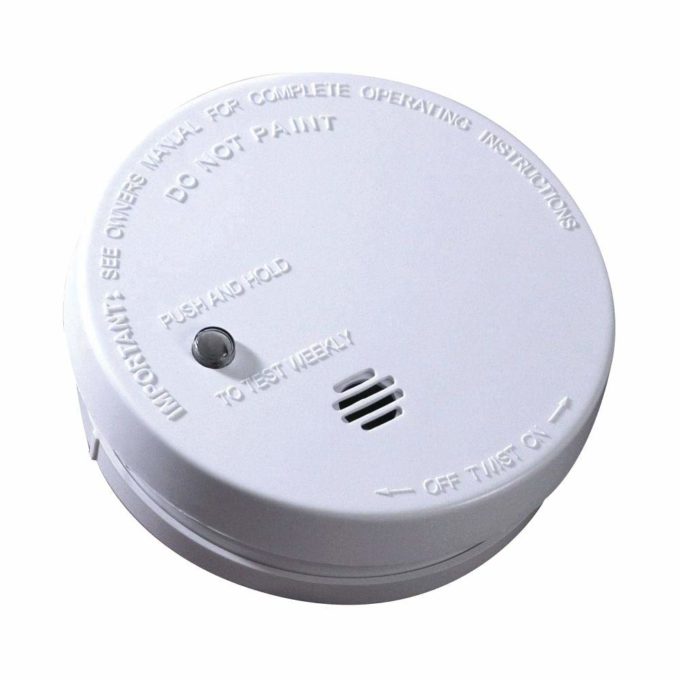
Kidde i9040 Battery-Operated Ionization sensor Compact Smoke Alarm
Pros: If you want a basic smoke alarm, this alarm provides what you need. This small, 4-inch diameter smoke alarm contains an ionization sensor for faster detection of flames.
Well-known within the smoke detector industry, Kidde provides some of the most economical alarms on the market.
Cons: Contains an ionization sensor only, no carbon monoxide detection, and less environmentally friendly.
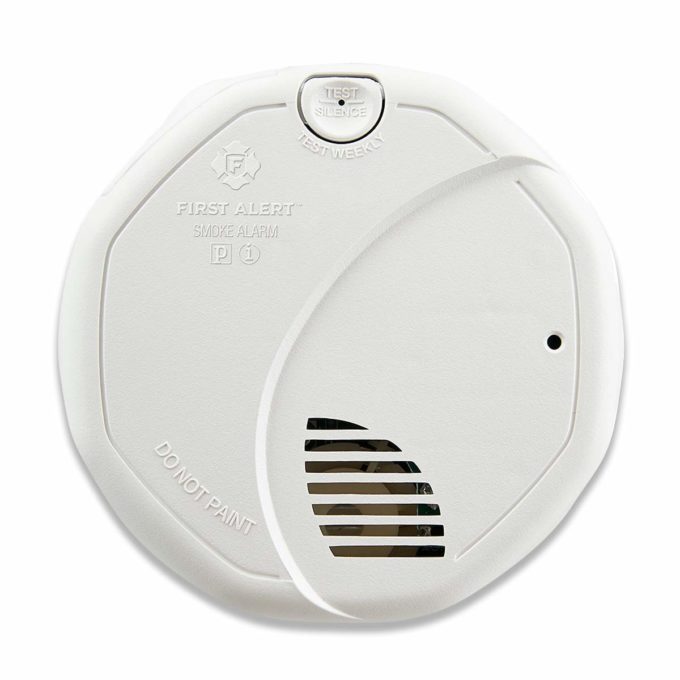
First Alert SA320CN Dual-Sensor Smoke and Fire Alarm
Pros: This smoke alarm contains both ionization and photoelectric sensors to provide early warning of fast-flame and smoldering fires.
It contains a loud 85-decibel siren to awaken the soundest of sleepers in your household. First Alert also leads within the fire protection industry.
Cons: No carbon monoxide detection and less environmentally friendly.
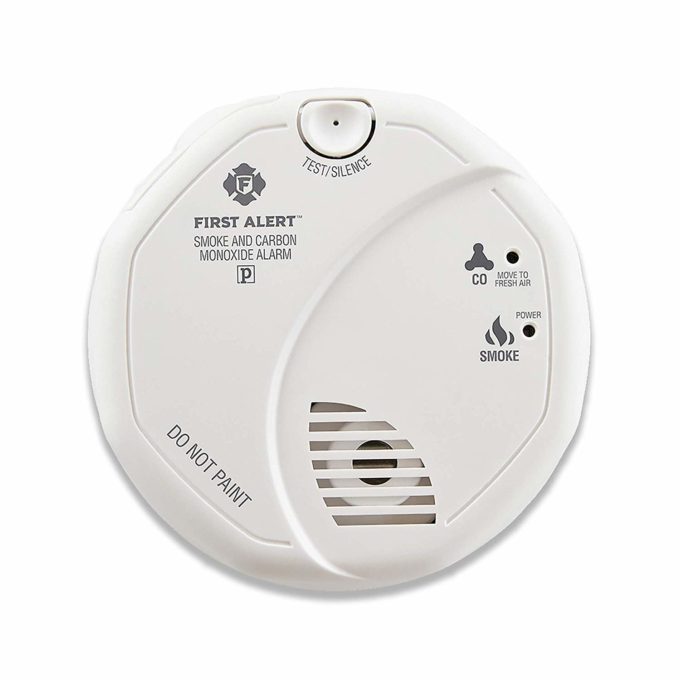
First Alert Smoke Detector and Carbon Monoxide Detector Alarm | Battery Operated, SCO5CN
Pros: This smoke alarm contains a photoelectric sensor, minimizing false alarms due to cooking smoke or shower steam.
This sensor allows for greater environmental friendliness.
Additionally, this alarm contains an advanced electrochemical sensor to detect carbon monoxide leaks from multiple sources, like faulty fuel-burning appliances, blocked chimneys, or generators running inside or too close to homes.
It also contains loud 85-decibel siren.
Cons: Affordable, but more expensive than previous two units. Not available in some states within the USA. If you also want an ionization sensor, this unit contains only the photoelectric sensor.

Nest Protect Smoke and Carbon Monoxide Alarm, Battery Powered (Second Generation)
Pros: If you want the elite option, the Nest smoke and carbon monoxide alarm exceeds all expectations!
This alarm contains a split-spectrum sensor to photoelectrically detect a wider range of smoke events from slow, smoldering to fast flaming fires.
It also contains heat, humidity, and ambient light sensors for greater ability to distinguish fires from false events and give you the surety the alarm currently functions properly.
The Nest alarm provides voice alert of the exact event location and an 85-decibel horn. Additionally, this alarm lights your way at night and continually checks battery charge to eliminate those alloying chirps.
If you love modern technology and integration, the Nest alarm connects by Wi-Fi, allowing communication to other installed Nest smoke alarms, and gives the ability to activate those alarms much like hardwired systems.
It integrates with other Nest products like thermostats to allow automatic shutdown of any furnaces during carbon monoxide alerts.
One of the best options includes the ability to receive alarms from any location via your mobile phone, letting you check while away from home.
Cons: Expensive compared to the other options, but unbeatable considering capabilities, integration, and protection.
Click HERE to view the full line of Nest home integration options.
Hardwired Smoke Alarms
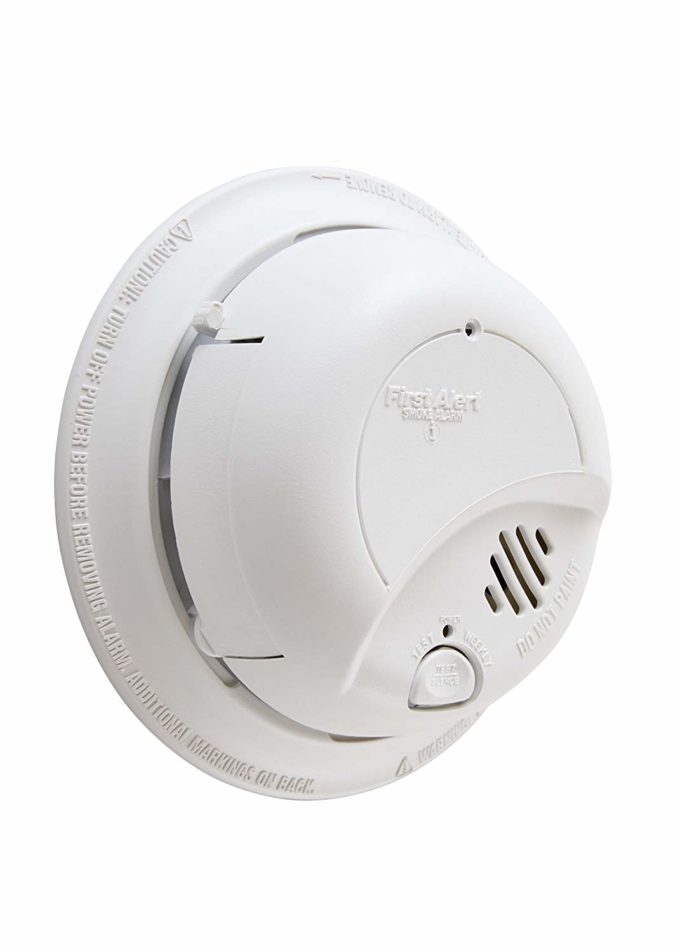
First Alert Smoke Detector Alarm | Hardwired with Backup Battery, BRK9120b6CP
Pros: This inexpensive, basic smoke alarm provides battery backup to ensure uninterrupted protection even during power failures.
Equipped with an ionization sensor and 85-decibel alarm, it can connect to other First Alert smoke alarms to ensure house-wide alert when one alarm detects smoke.
Cons: Requires wired connection if not existing already. Contains an ionization sensor only, no carbon monoxide detection, and less environmentally friendly.
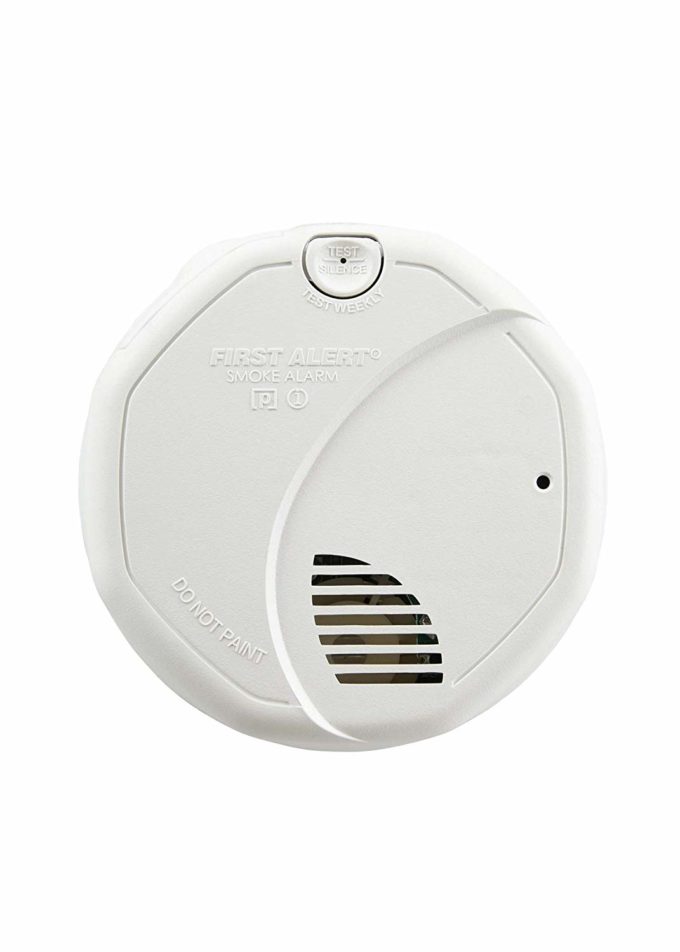
First Alert Smoke Detector, Photoelectric and Ionized Alarm | Hardwired with Battery Backup, BRK 3120B
Pros: The BRK 3120B from First Alert gives another hardwired smoke alarm option with battery backup.
This particular model contains both ionization and photoelectric sensors, allowing for earlier detection of fast-flaming and smoldering fires.
It contains a loud 85-decibel alarm, and can also interconnect with other First Alert smoke alarms for household-wide notification.
Cons: Requires wired connection if not existing already. Contains no carbon monoxide detection capability, and is less environmentally friendly due to ionization sensor.
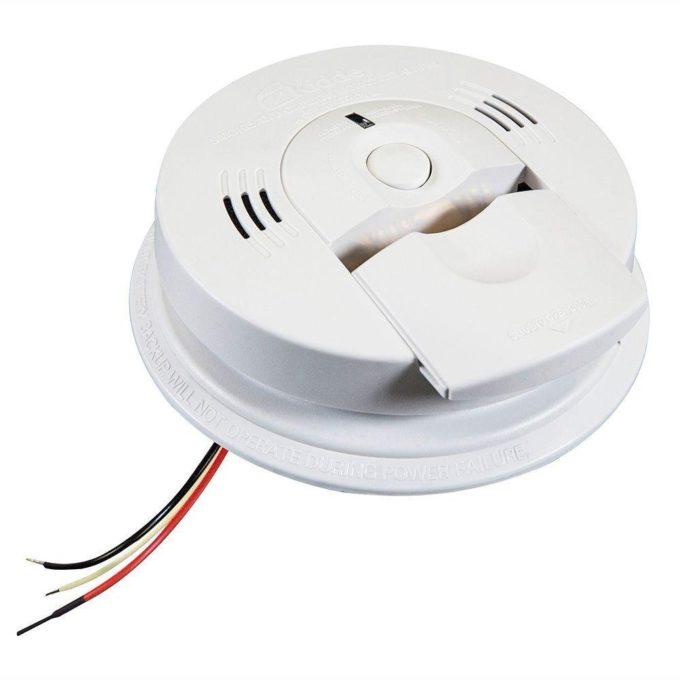
Kidde KN-COSM-IBA Hardwire Combination Smoke/Carbon Monoxide Alarm
Pros: This affordable Kidde smoke alarm model detects both smoke and carbon monoxide, and uses ionization sensor technology for fire detection.
Like the previous hardwired models, it contains battery backup, and interconnection capability.
Additionally, its talking alarm announces the hazard type detected.
Cons: Requires wired connection if not existing already. Less environmentally friendly due to ionization sensor type.
Special Needs Options
As a mother of a child with autism, mindfulness of those who need special consideration. These include individuals with special needs, those with different sensory requirements, and people on both ends of the age spectrum.
Below are three options identified to assist those fitting this description. Note: Please ensure the smoke alarm matches the specific needs required, given each person’s alert stimulus type and threshold varies.
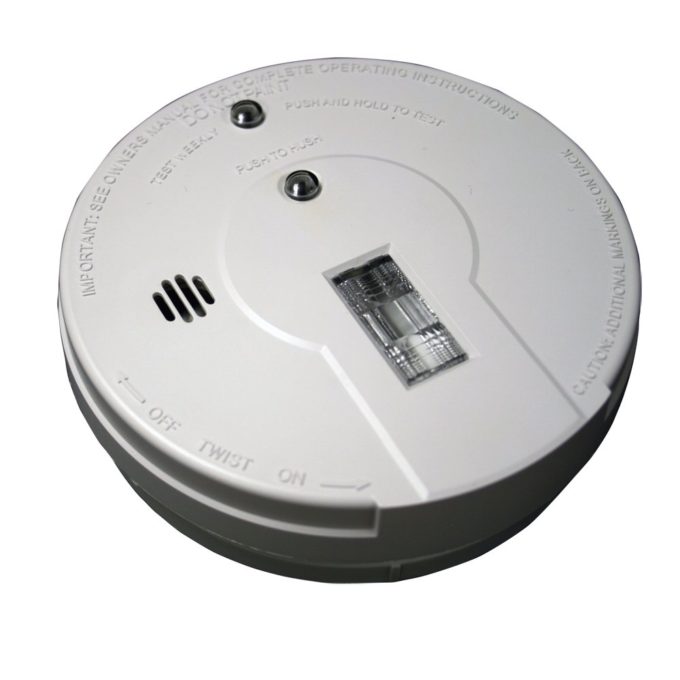
Kidde Battery Operated Smoke Detector Alarm with Safety Light | Model i9080
Pros: This inexpensive battery operated smoke alarm contains a safety light to illuminate an escape pathway.
Especially suited for hallways and stairwells, it could also provide additional notification to those who need a stimulus other than sound to alert them of danger.
Cons: Contains an ionization sensor only, no carbon monoxide detection, and less environmentally friendly. Requires light stimulus to awaken someone, so not optimal for every situation.

First Alert SLED177 Hardwired Hearing Impaired Led Strobe Light
This alarm contains a powerful 177 candela LED strobe light to provide visual warning for those who need this type of alert.
A trouble signal synchronization causes strobes to flash in unison when multiple units are installed.
Cons: Requires wired connection if not existing already. Contains an ionization sensor only, no carbon monoxide detection, and less environmentally friendly. Requires light stimulus to awaken someone, so not optimal for every situation.
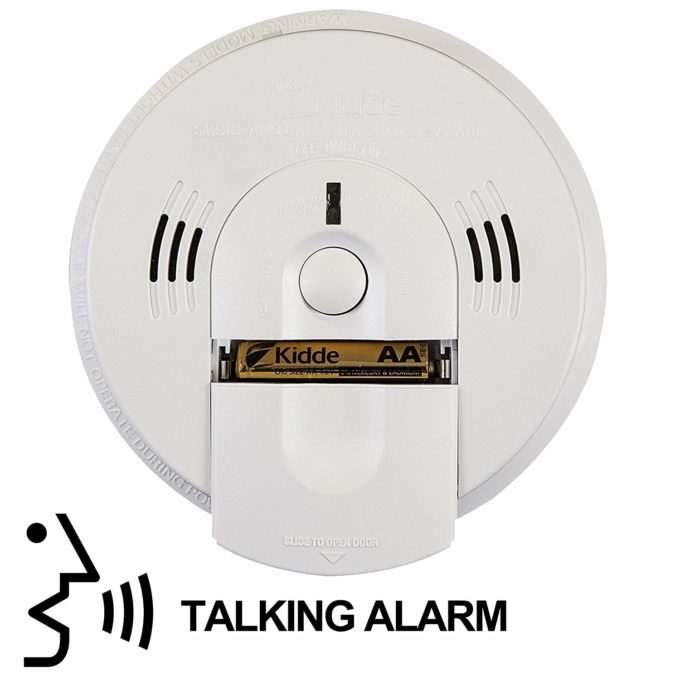
Kidde 21026043 Battery-Operated(Not Hardwired) Combination Smoke/Carbon Monoxide Alarm with Voice Warning KN-COSM-BA
Pros: This battery operated alarm detects smoke and carbon monoxide. It produces both an 85-decibel alarm and also voice announcements of the specific threat identified.
The voice also indicates when the battery is low. Works well for someone who needs voice description to understand the meaning of the alarm.
Cons: Contains an ionization sensor and less environmentally friendly due to this type of sensor.
Thanks for reading. I hope you have found this “how to stop smoke alarm beeping” post helpful. I know how bothersome those chirps can be and I know several friends who were just as clueless about it as I was.
Thankfully, the solution is simple and the peace of mind is well worth it.
Remember, house fires are more common than people realize. One of the most deadliest fires start out as electrical fires. Most people sleep through these because they are silent and within the walls.
Luckily, smoke detectors can pick up on even the slightest amount of smoke—even from electrical fires. This is why it’s important that you address any beeping or malfunction in your fire alarm immediately.
Stay diligent! Stay safe!
Note: Should you choose to purchase a new smoke alarm by clicking through the provided links, I could receive a commission from Amazon at no additional cost to you. Thank you for your support.

